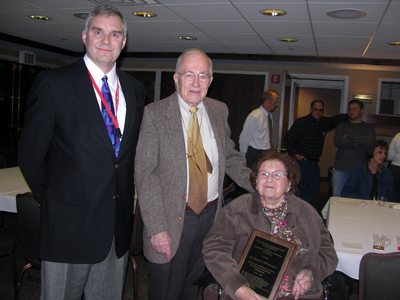 |
Robert Binhammer, Ph.D. |
The first-year medical student was hammered.
But, it wasn’t from a weekend party.
He had just emerged from his gross anatomy course, where his teacher had challenged him to think and find his own answers.
Like other frustrated students before him, he muttered, among other things, a saying made popular by his predecessors: “You haven’t been hammered until you’ve been hammered by Binhammer.”
Robert Binhammer, Ph.D., knows first-year medical students see him as demanding.
“Yeah, they think I’m tough,” he grins. “I’ve been known as ‘The Hammer’ forever.”
For the past 50 years — including 26 at UNMC — Dr. Binhammer has introduced thousands of students to the rigors of medical school.
Medical students in the 10-week gross anatomy course he coordinates quickly learn he’s demanding, but fair.
“It’s important to start them off on the right foot,” Dr. Binhammer said. “We get them to recognize how to deal with a mammoth amount of information and let them know we’re interested in problem-solving, not memorizing data.”
After a few years, most students realize Dr. Binhammer had their best interests in mind as he challenged them to think deeply about the material they were covering.
“Zillions of students tell me that when they stop and think about anatomy, they are grateful for the approach I took.”
His father — a math and business teacher in Watertown, Wis., — and his mother — a second-grade teacher — undoubtedly influenced his career path.
Upon graduating from high school, Dr. Binhammer went to his uncle’s 60-acre fruit farm, without future plans. There, he met a Kalamazoo (Mich.) College senior, who asked what college he would be attending.
“I told him I hadn’t done anything about it and he said I should think about Kalamazoo.”
At his suggestion, Dr. Binhammer wrote the College a letter and within three weeks was signed up as a student.
“I had never been there and didn’t know anything about it, but it turned out to be an absolutely first-rate choice.”
Four years later, fate guided another major life decision.
The biology major had no future plans during his senior year until a Kalamazoo alumnus and professor from the University of Texas-Galveston visited campus.
Two weeks later, an impressionable Dr. Binhammer was headed to Galveston, where he would earn his Ph.D. in 1955.
“I had no concept of where that was or what this field was all about,” he admits.
During his first year in Galveston, he lived on $900 — for the entire year.
“There were a lot of 19-cent lunches of soup and crackers,” he quips.
Soon after, he married his college sweetheart, Anne, and upon graduation, moved to Cincinnati, where he taught anatomy and conducted research on the effects of radiation.
He also served as an assistant dean and later as an associate dean.
In 1979, Dr. Binhammer came to UNMC as the associate dean for student affairs and curriculum in the College of Medicine, one year after Alastair Connell, M.D., left Cincinnati to become dean of the UNMC College of Medicine.
“Fortunately, I got an appointment in anatomy at the time,” he said, as his focus shifted full time to the department in the mid-1980s. He has coordinated the gross anatomy course at UNMC for the past dozen years and coordinates the six-week neurology core course that first-year medical students take in the spring.
It’s through the anatomy course, though, where “The Hammer” leaves his biggest impression on students. He’s known for posting a “question of the day” before the start of class and for standing 6 feet tall on the Wittson Hall Amphitheater table wearing his plain, white “badminton shorts” so all 240 eyes can see his lecture on gaits.
“There’s a lot of hootin’ and hollerin’, but it’s an unbelievably effective way to teach the image of normal gait and how we walk and what muscles are active in what phase and what happens if you lose some of those,” he said. “I’ve decided as long as I don’t fall off the table or lose my balance, I will keep doing the gait lecture.”
Dr. Binhammer, meanwhile, tells students they’re in one of the best anatomy programs in the nation.
 |
Pictured below (from left) are: Drs. Hans Rath, Paul Gardner, Kenneth Metcalf, Robert Binhammer, Warren Stinson, Gordon Todd, Jorge Rodriguez-Sierra and Barbara Murphy. |
The course is even better since adding “living anatomy,” he said. The concept pairs students, who test range of motion and muscles; draw lungs and the heart on each other; and find pulses, joints, nerves and “all the bony prominences you can palpate,” Dr. Binhammer said.
The students are tested in a private setting with a faculty member present.
“It gets anatomy out of the dissecting room so it’s not dead.”
The Hammer is on the department’s teaching schedule through 2008, but says that doesn’t mean this 77-year-old is planning his retirement.
“If you get good at something, you ought to keep doing it until you can’t.”